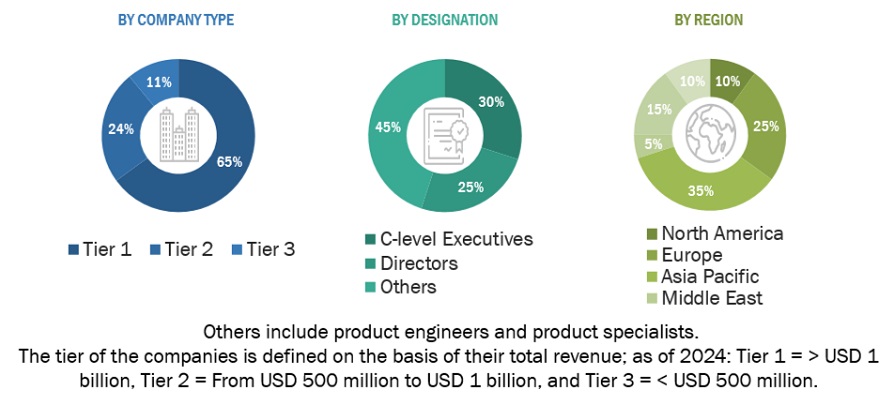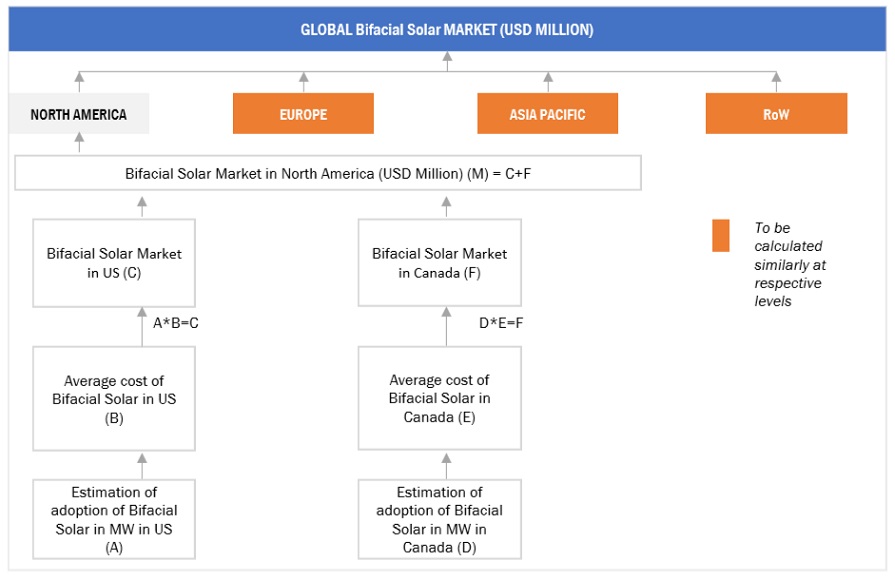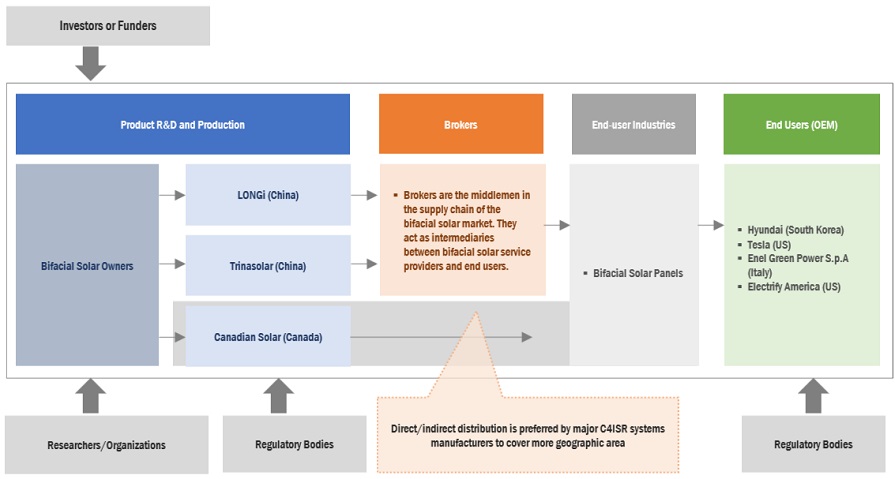The study involved major activities in estimating the current size of the bifacial solar market. Exhaustive secondary research was done to collect information on the peer and parent markets. The next step was to validate these findings, assumptions, and sizing with industry experts across the value chain through primary research. Both top-down and bottom-up approaches were employed to estimate the total market size. Thereafter, market breakdown and data triangulation were used to estimate the market size of the segments and subsegments.
Secondary Research
This research study on the market involved the use of extensive secondary sources, directories, and databases, such as Hoover’s, Bloomberg, Factiva, IRENA, International Energy Agency, and Statista Industry Journal, to collect and identify information useful for a technical, market-oriented, and commercial study of the market. The other secondary sources included annual reports, press releases & investor presentations of companies, white papers, certified publications, articles by recognized authors, manufacturer associations, trade directories, and databases.
Primary Research
The bifacial solar market comprises several stakeholders, such as bifacial solar manufacturers, technology providers, and technical support providers in the supply chain. The demand side of this market is characterized by the rising demand for storage solutions in various applications such as energy, mobility, industrial, and transportation. The supply side is characterized by rising demand for contracts from the industrial sector and mergers & acquisitions among big players. Various primary sources from both the supply and demand sides of the market were interviewed to obtain qualitative and quantitative information. Following is the breakdown of primary respondents:

To know about the assumptions considered for the study, download the pdf brochure
Market Size Estimation
Both top-down and bottom-up approaches were used to estimate and validate the total size of the market. These methods were also used extensively to estimate the size of various subsegments in the market. The research methodology used to estimate the market size includes the following:
-
The key players in the industry and market have been identified through extensive secondary research, and their market share has been determined through primary and secondary research.
-
The industry’s value chain and market size, in terms of value, have been determined through both primary and secondary research processes.
-
All percentage shares, splits, and breakdowns have been determined using secondary sources and verified through primary sources.
Bifacial Solar Market Size: Top-Down Approach

To know about the assumptions considered for the study, Request for Free Sample Report
Bifacial Solar Market Size: Bottom-Up Approach

Data Triangulation
After arriving at the overall market size from the above estimation process, the total market has been split into several segments and subsegments. Data triangulation and market breakdown processes have been employed to complete the overall market engineering process and arrive at the exact statistics for all the segments and sub-segments, wherever applicable. The data has been triangulated by studying various factors and trends from both the demand- and supply sides. Along with this, the market has been validated using both the top-down and bottom-up approaches.
Market Definition
The bifacial solar market is a leading segment of the solar energy sector, focusing on the design, manufacturing, and use of bifacial solar panels. These panels are engineered to capture sunlight on both their front and back surfaces, significantly increasing energy production compared to traditional monofacial panels. By utilizing both direct sunlight and light reflected from the ground and nearby surfaces, bifacial panels offer enhanced efficiency and output. This dual-sided capability is particularly advantageous for installations over reflective surfaces such as snow, sand, or concrete, making them ideal for various applications, including large-scale solar farms, commercial rooftops, and residential setups. As global demand for efficient and cost-effective renewable energy solutions grows, bifacial solar technology is emerging as a key driver of industry progress.
Key Stakeholders
-
Bifacial solar Dealers and Suppliers
-
Government and Research Organizations
-
Power and Energy Associations
-
Repairs and Maintenance Service Providers
-
State and National Regulatory Authorities
-
Research And Consulting Companies in the Clean Energy Generation Sector
-
Organizations, Forums, Alliances, And Associations
-
Industrial Authorities and Association
State and National Regulatory Authorities Objectives of the Study
-
To forecast the bifacial solar Market based on type, frame type, cell technology, application and region in terms of value
-
To describe the market for four key regions: Asia Pacific, North America, Europe, and Rest of the World, along with their country-level market sizes in terms of value
-
To provide detailed information regarding key drivers, restraints, opportunities, and challenges influencing the growth of the market
-
To strategically analyze the micromarkets with respect to individual growth trends, prospects, and contributions to the overall market size
-
To provide the supply chain analysis, trends/disruptions impacting customers’ businesses, market map, ecosystem analysis, tariffs and regulations, pricing analysis, patent analysis, case study analysis, technology analysis, key conferences and events, trade analysis, Porter’s five forces analysis, key stakeholders and buying criteria, and regulatory analysis of Market
-
To analyze opportunities for stakeholders in the bifacial solar and draw a competitive landscape of the market
-
To benchmark market players using the company evaluation matrix, which analyzes market players on broad categories of business and product strategies adopted by them
-
To compare key market players with respect to product specifications and utility
-
To strategically profile key players and comprehensively analyze their market rankings and core competencies
-
To analyze competitive developments, such as contracts & agreements, investments & expansions, mergers & acquisitions, new product launches, partnerships, joint ventures & collaborations, in the Market.
Available Customizations:
With the given market data, MarketsandMarkets offers customizations according to the specific requirements of companies. The following customization options are available for the report:
Product Analysis
-
Product Matrix, which provides a detailed comparison of the product portfolio of each company
Company Information
-
Detailed analyses and profiling of additional market players



Growth opportunities and latent adjacency in Bifacial Solar Market